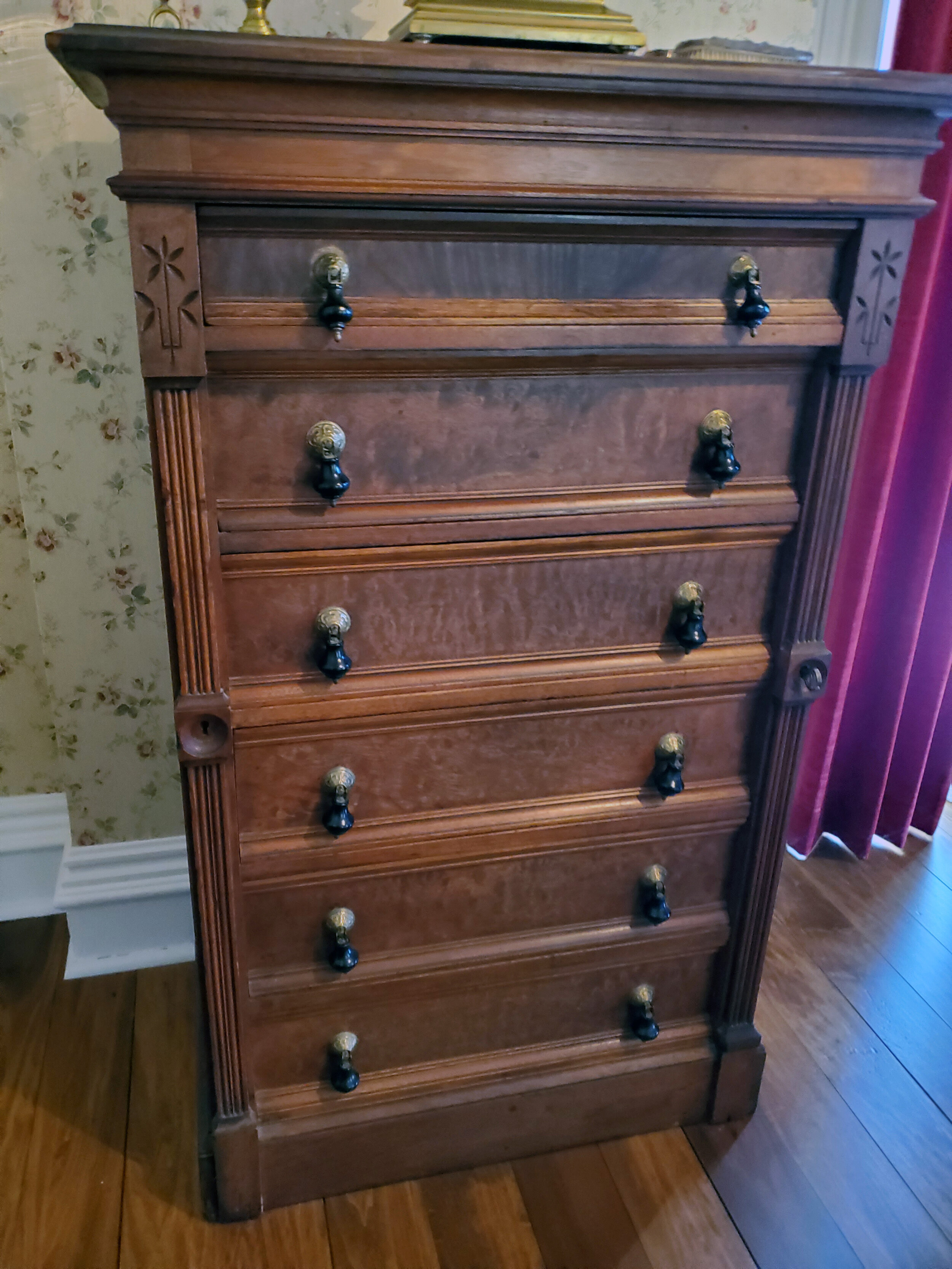The Side-Locking Chest of Drawers
Everyone who works or volunteers at the Ruthmere Mansion or the Havilah Beardsley House has favorites – favorite rooms, favorite stories and favorite collection pieces. With so much history, so many stories and such unique representation found in the history and décor, it would be difficult to not have a favorite or two.
I am the program coordinator for the Ruthmere Foundation. I joined the Ruthmere team two years ago (this is my third year) and have enjoyed learning the stories these beautiful and historic structures have to share. I am an avid history buff, with a penchant for visiting museums wherever my travels take me. Most weekends you can find me at the Havilah Beardsley House, the residence of the founder of Elkhart, his son James Rufus Beardsley, and many other families who have called it home.
For me, one of my favorite pieces of furniture is found in the upstairs master bedroom. This room is in and of itself a beautiful room. The view from the 10-foot windows looks down Main Street to the heart of Elkhart. Overlooking the river, it must have provided the occupants of the house a stunning view as the city grew in the century plus since Havilah Beardsley purchased the land from Potawatomi Chief Pierre Moran.
Locking Chest of Drawers, circa 1870s
In this room is one of my favorite pieces. It is an 1870s circa chest of drawers. It was donated to the Havilah Beardsley House by Oscar Schricker in 2015, shortly before the restored home opened to the public as a museum. It was originally owned by a Jay Cooke, but few details are known about the original owner. What makes this chest of drawers a personal favorite is the side-locking mechanism that keeps the contents of the drawers secure.
Drawers with locks are not necessarily unique, but this particular style is wonderful. My grandfather was somewhat of a furniture craftsman so perhaps my fascination with this beautifully designed and engineered piece may be somewhat biased, but it truly is a unique piece as is the history of these type of locking bureaus.
The locking mechanism
These types of dressers are also known as “boarding house dressers” because the locking mechanism protected the room occupant’s valuables from theft. It is a fitting name that no doubt explained the purpose of the piece well.
These chests of drawers are also referred to as “Wellington Chests,” named after Arthur Wellesley, the first duke of Wellington. Wellesley was commissioned as an ensign in the British army in 1787, eventually moving up to earn the rank of colonel in 1796 and governor in 1799. He reportedly used a side-locking chest during military campaigns. Furniture that was engineered to break down or fold for easy moving was common in military encampments throughout the 1800s. These furniture pieces stored coins, documents, and other important papers within the 6 to 12 shallow drawers.
The sunflower motif
While many of these chests of drawers were made in England, American furniture makers also crafted similar pieces. One of these was the Phoenix Furniture Company in Grand Rapids, Michigan, which was preceded by the Atkins and Soule cabinetmakers. In 1873, the era that the Havilah Beardsley side-locking dresser originates, Phoenix Furniture made bedroom suites using walnut and ash. One trademark embellishment linked to this company was a stylized sunflower design on its furniture pieces, which was similar to designs found on Eastlake furniture, a highly prized, top-of-the-line European furniture style popular in the 1870’s. According to information on the history of Phoenix Furniture, this sunflower motif was distinctive of work done by furniture designer David Kendall.
The stylized sunflower found on the side-locking chest of drawers in the upstairs bedroom matches the dresser in the same room that belonged to Philo Morehouse, one of the first bankers in Elkhart. Other than this carved motif, there are differences in the two pieces. For example, the drawer pulls are similar in style but different in color. The dresser has a marble top and the chest of drawers is wood.
The drawer pulls on the chest of drawers
Another clue as to the chest of drawer’s manufacturer is the rectangular paper shipping tag affixed to the back of the chest of drawers. According to Phoenix Furniture Company history, this was the way the company shipped its pieces. The company swapped metal plates for the paper tags in about 1890.
Paper shipping tag, affixed to the back of the chest of drawers
Locking furniture was not revolutionary. Dresser drawers, desks, armoires, and cabinets were often outfitted with locks. The earliest locking devices date back to 4000 B.C., discovered by 19th century archeologists at the site of a former palace in Iraq in what would have been known at the time as the Kingdom of Assyria. This early wooden pin lock design from Mesopotamia was refined and made part of the architecture by the Egyptians. It was not until the Middle Ages when European craftsmen designed a metal version and the iconic skeleton key.
The skeleton key
The Havilah Beardsley piece has a skeleton key which unlocks a hinged panel that when closed keeps the drawers from opening. A faux lock on the other side mimics the operational lock on the other, designed to perplex a would-be thief looking for easy access to valuables inside.
When giving tours of the home I always talk about the side-locking chest of drawers. I demonstrate how it opens and enjoy the reaction from our guests. It is a nod to the innovative spirit of furniture makers who strived to not only make furniture beautiful, but functional as well.






